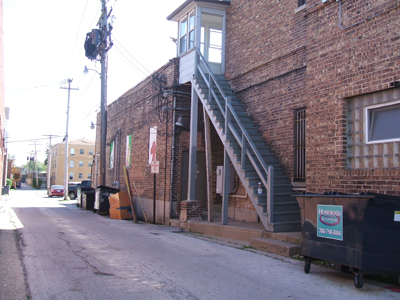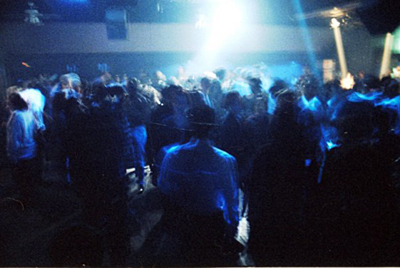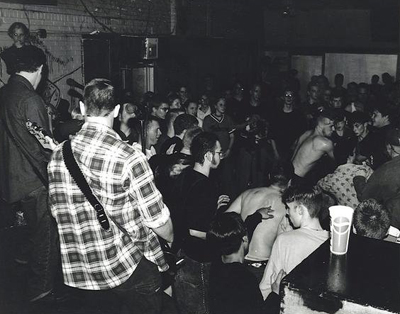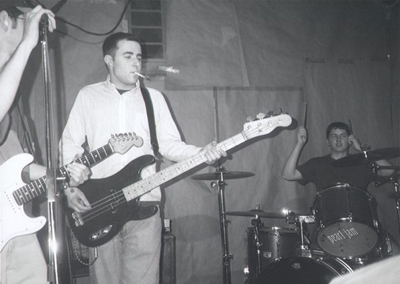For an occasional series in Transmission, we'll be revisiting the legacy of old music venues in the Chicago area that have since closed down — places long gone, boarded up and turned into condominiums or shiny storefronts. The places that once contained the voices of the passionate few who crammed themselves in compact spaces night after night to see their favorite underground band play that first chord. Starting off the series, Transmission looks at Off the Alley, an all-ages club in south suburban Homewood that was one of the first venues to host several influential punk bands, including The Queers, Alkaline Trio and Winepress. E-mail suggestions about clubs you would like to see featured to smburt@gmail.com.

What remains: a storefront turned into a martial arts center, and, behind that, an alley, with three conspicuous blue garbage bins, overflowing with this week's trash from yesterday's memories. In three windows, there are painted images of familiar cartoon characters — one that looks like Clifford the Big Red Dog, Tweety Bird and Sylvester the Cat. Behind a No Parking sign, a "South Side Anger" sticker remains attached to the post.
Twenty years ago, teens from the south suburbs and northwest Indiana considered this alleyway their second home. When Fridays and the weekends finally came around, they drove or walked to this alley to check out Off the Alley, an all-ages music and dance club that opened in the fall of 1989 in downtown Homewood. A small October 13, 1989 Chicago Tribune news brief begins, "Homewood's first juice bar and dance club for teenagers will open in the back of a record store next month."
That record store is Record Swap, formerly at 18061 Dixie Hwy., now home to the Draco Academy of Martial Arts. The village board approved the club unanimously but only under certain conditions: owners Theodore and Robert Diener were required to have at least four security guards on duty while the club was open, "particularly to discourage customers from loitering in the alley and to enforce curfew restrictions."
A few years later, and all of these mundane village ordinance details didn't really matter anymore: Off the Alley was now a club, slowly attracting anyone with a punk heart or desire to dance away inhibitions. Part of its story begins with the people who danced.
Outsiders
Jessica Wolfe, 36, Chicago
Sometimes, a conga line would form. Wolfe loved the music at the club, but she also remembers spending hours dressing up with her sister to "to get our hair to do those unnatural things like get into spikes or teased up Siouxsie Sioux style. It was a bit of a punk-rock fashion show for us girls, and we loved it." All this for preparation for a night of dancing and music.
Wolfe began going to Off the Alley around 1988, when she was 14 years old. She split her time between Off the Alley and Medusa's, another all-ages club.
"I used to find it fun when an impromptu conga line would happen to bands like Nitzer Ebb or Front 242," she remembers.
Wolfe grew up in nearby Park Forest and started going to Record Swap just as bands like The Cure and Depeche Mode began dominating her record collection.
"Back when I attended, it was mostly music, but I remember that it was a great place for dancing and I would play suggestions and music I couldn't hear anywhere else," she says.
DJs would spin anything from Bad Brains, to the Specials, to the Sisters of Mercy, and "they were not afraid to play the stuff that the radio wouldn't play, but what I was listening to."
Wolfe describes herself as someone who was "a bit of a nerd" back then, but at Off the Alley, she could wear her "black clothing, and dance around like a fool, and not feel too out of place." Teens like Wolfe, and many others, began to feel in place.

Off The Alley Dance (Courtesy Paul Rogers)
Paul Rogers, 35, Alsip
Rogers began going to the club in 1990 when he was 17 years old. He and his friends often shopped at Record Swap, run by the same owners as Off the Alley. "My friends and I used to always go shopping there and would hear the music always coming from the back of the store," Rogers says in an e-mail interview. "One day, we decided to check it out. It was great because it was an underage juice bar and it was some place for us to go on the weekends."
Even though the club didn't sell alcohol, Rogers and his friends would drink across the street before going to the club. He liked the club so much that he began working for Record Swap in 1992. In 1994, he began DJ'ing under the name DJ Nitz, spinning New Wave music from the '80s. Off the Alley was more than an important place for him at an important time — it was part of a movement too fluid to classify.
"Before Grunge," he recalls, "there were a lot of people already wearing flannels, Doc Marten boots, chains attached to wallets, piercing in weird places, people who'd wear all black (Goth), men who'd wear make-up! We kind of classified ourselves as Alternative back in the day. But recently that word has been thrown around and abused. It's not even worth using anymore. The crowd that hung around Off the Alley always seemed to be ahead of the times. What we were then is what Grunge and Goth became a few years later. This was a place we could all go and have a good time and listen to music that not many people have heard of at the time."
But the live bands, it turns out, weren't what first attracted Rogers to the club.
"I've never seen any concerts there," he says. "I just really enjoyed setting up the club. I used to have to set up the lights so the disco ball would shine just right. I would have to fill the smoke machine and make sure it worked. I'd also have to make sure the levels on the mix board were set right. I would lay out a set list to make sure I kept people dancing all night."
Kristen (Ulrich) Erickson, 34, Des Moines, Iowa
The dancing, it turns out, also attracted Erickson, who lived within walking distance to the club in the late '80s and early '90s. Erickson went to the club most Friday and Saturday nights, eager to move her way to the dance floor and meet new people beyond her classmates at Homewood-Flossmoor High School. "I feel like I was there all the time," she laughs in a phone interview from her home in Iowa.
Erickson and her family moved from Dolton to Homewood when she was in 7th grade because of the stronger education system. But her family was not as affluent as some of the families who lived in the area then, so she found herself feeling a little alienated in school.
"I was kind of quiet, nerdy and shy until right around age 15," she says. "I changed to a whole different group of friends and started feeling better about myself...I got more self-confident around then. Some people hit that point in college, some people when they're older. I hit it when I was 15."
Off the Alley, in Erickson's mind, was a place for these outsiders to hang out, even if they only saw each other at the club. "It was a great thing for me," she says. "I feel like it fit really well with my needs at the time."
Walking into the club, Erickson recalls turning into an alley in downtown Homewood and walking into a non-descript hallway. Turn left, and she would see a big room with a juice bar, a video screen and the dance floor. This club belonged to them.
"Although it was an all ages club, it really made me feel like I was going to a real club," she continues. "It had the feel of being a real legitimate club, and not being a thing for kids, even though it was for kids as an all-ages club."
Nearly every weekend, Erickson pressed her feet against large rectangular designs on the dance floor, where guys in combat boots would create mock mosh pits that were more polite than aggressive. She remembers Erasure songs playing often in the background.
While some people outside of the club took drugs and drank, Erickson said she never felt the pressure, "which was kind of nice."
"I did not drink. I did not do drugs. I didn't have sex then, and I didn't feel like that was a problem," she says.
And while a lot of beginning punk bands played Off the Alley, Erickson says she was more into the dance scene, but she never felt alienated from the punks.
"I'm 5 '2 and 115 pounds," she says. "I'm a tiny, little person. I was into the alternative music...but not super into the punk. I was more into the dancy kind of stuff. There was a whole mix of people there. I never felt like the people who listened to punk music had anything bad to say about me dancing."

Off The Alley (Courtesy of Steven Barick)
Young Punks
Another part of the story begins with the people who were there for the music. Pretty soon, an article in the Chicago Sun-Times would label them "young punks," and the "new generation of rock 'n' rollers."
David Stein, 32, Dyer, Ind.
Stein was there for the music. He started going to the club in the fall of 1992. He was 17 at the time and living in Dyer, Ind., about 20 minutes from Homewood.
Before he and his friends had licenses to drive, they would hang out at The Rink, an indoor skating club in Merrillville, Ind. But, Stein says in an e-mail, they all knew that "Off the Alley to us was the little big time. It had an entire audience outside of the kids we knew that were into the same music as us. It had a real stage and a sound guy and even employees serving expensive pop."
Stein played guitar in a band called Catch 22, and frequented Off the Alley on weekends to hear his favorite bands. Some of Stein's favorite bands playing there included The Queers, Snap Judgment, Sled, Winepress, The Bollweevils and Waco 51.
"I remember it smelled like clove cigarettes, and it was hot as hell," Stein recalls. "It had a small back room to store the equipment before the shows, which is where the bands would hang out. There [were] a few booths along the back wall, but mostly, it was standing room."
By the mid-'90s, Off the Alley had slowly established itself as a destination club. In a 1995 Chicago Sun-Times article on all-age clubs, freelance writer Mo Ryan describes Off the Alley as the club where kids "sport the dyed hair or suspenders-and-Doc Martens skinhead look of punk's first wave, and a few of them recycle the elitist attitudes that drove the punk scene into the musical fringes in the late '80s and early '90s." She quotes one unnamed high school student who jokes, "My mom used to think they sacrificed animals here. She thinks a lot of freaks hang out here."
In her article, Ryan points to the importance of the all-ages scene, quoting a young promoter who says he tells up-coming bands to play the local all-ages circuit first before setting eyes on bigger clubs such as the Metro. She also points to a problem that would haunt Off the Alley: the lack of money in all-ages venues because they cannot sell alcohol.
One of the kids quoted in the article is 15-year-old Eric Boyle, who played in several bands, including Johnny One Note, The Laxatives, Stillwell and Kotter. Boyle told Ryan, "I come here to support bands because when I'm in a band, I want people to come and see me. It's important to support the bands, even if they're bad. If people tell them they (stink), they'll get better." Boyle, now 29, still remembers how Off the Alley affected him.

Eric Boyle playing in Stillwell
Eric Boyle, 29, Chicago
Boyle grew up in Homewood, about a mile away from OTA. He was about 13 when he first started going the club, lured to the club by his brother Mike's friends.
"The first time I went was with one of my brother's friends. He was walking past our house on his way there and asked me if I wanted to go. I didn't go again for at least a year after that," he remembers in an e-mail interview.
That changed, however, during Boyle's freshman year of high school. One day, he and his friend Jesse Haskell were hanging out at Record Swap a lot, talking about music and starting a band. They chatted with Ryan DeYoung, who worked at Record Swap and booked bands for OTA, "and he invited us to see his band Winepress at Off the Alley. From then on I was pretty much a regular," Boyle recalls.
He and Haskell played their first show on December 31, 1993. Inside, he remembers mostly black walls "with some gray accents here and there." The inside of neo on Clark Street reminds him a bit of the club.
Beyond his band playing there, Boyle says some of the most memorable shows he saw there included Jawbreaker, some time in spring of 1994, and Lifetime in summer 1997. Though he says the club had a tendency to short change bands, this didn't stop a lot of great bands from playing there.
"OTA exposed us to underground music and really changed our lives in a lot of ways," he says. "I can't imagine what music I'd be listening to right now without it. It showed me that there was a lot of great music that wasn't getting played on the radio and MTV. I'm sure I'd be a completely different person if OTA never existed."
Boyle recently started playing music again in a band called Needle Age with some other musicians who played Off the Alley, though Boyle only met them recently.
John Benetti, 29, Chicago
Benetti began going to Off the Alley in 1992, when he was 13. A friend's band was playing, and he was "scared shitless," but he was still drawn to the club. "I was definitely an outcast and a place like that had a lot of appeal to me," he says in an e-mail interview. He ended up working at Record Swap and at Off the Alley from 1997 to 1999, booking bands and managing the sound.
What made the club special in Benetti's mind? "All ages / no booze / cheap tickets / great bands / strong scene. You don't see that combo anymore in Chicago," he says.
Every time he walked in the club, he remembers it being dark, and "it was always pretty full and smokey. It was also very intimidating when I was 13/14. [There were] a lot of older people who all seemed to know each other. Years later, you realized that everyone pretty much felt the same way."
Some of his favorite bands included Jawbreaker, "the band that defined that era for me," The Bollweevils and Winepress.
Aaron Keefner, 27, Chicago
One of the youngest among the group, Keefner started going to the club in 1993, when he was just 11 years old. He grew up in Glenwood, a small suburb neighboring Homewood. "I was attracted to Off The Alley because it had such a cool scene that hung out there," he recalls in an e-mail interview. "I loved the music they showcased and even if the bands sucked, it was a good place to spend a Friday or Saturday night."
When you first entered the club, Keefner remembers it being "totally black inside. You walked through the door, went down a short hallway, the bar was in front of you on the right, there was a small stage in the left front corner, and then booths in the back and this tall black thing in the back corner. I used to hop up on it and watch shows from up there."
Some of his favorite bands that played there included Alkaline Trio, who played some of their first shows there, as well as Tuesday, Mushuganas, Zoinks!, Boris The Sprinkler and two bands from H-F: Kotter, which Boyle played in, and AYA.
Like a lot of people who frequented Off the Alley, Keefner reiterates one simple thing about the club: "There really is no club like OTA anymore."
"A Pair"
Off the Alley closed when Record Swap went out of business in January 2000, just as all-ages clubs became less popular around the city and owning an independent record store became more challenging. Benetti, who worked at both Off the Alley and Record Swap, blames part of its demise on "bad management, stealing employees, and an over all sense of 'spread too thin.'" He remembers that Winepress may have been booked to play one of the last shows on Halloween or November 1. Though Winepress's exact playlist that night isn't known, it's likely the band may have played "Stay Awhile," now up on the band's MySpace page: "Well I've tried so hard for so long/And now nothing can go wrong/You and me, we make a pair/They say it's wrong, but I don't care/I'll meet you there."
Off the Alley Playlists:
Jessica Wolfe:
Front 242, "Headhunter"
Pailhead, "I Will Refuse"
Ministry, "Everyday is Halloween"
KMFDM, "More and Faster"
Soft Cell, "Tainted Love"
Nitzer Ebb, "Join in the Chant"
Thrill Kill Kult, "Kooler than Jesus"
Siouxsie and the Banshees, "Cities in Dust"
Depeche Mode, "Personal Jesus" (We'd always stomp the beat out very loudly when this came on)
The Smiths, "How Soon in Now" (always very popular)
Kristen Erickson:
Front 242, "Headhunter"
Deee-lite, "Groove Is in the Heart"
Siouxsie & the Banshees, "Cities in Dust"
PTP, "Rubber Glove Seduction"
Nitzer Ebb, "Join in the Chant"
Joey Beltram, "Energy Flash"
My Life with the Thrill Kill Kult, "Kooler Than Jesus"
Ministry, "Stigmata"
The Stone Roses, "Fool's Gold"
Pailhead, "I Will Refuse"
Front 242, "Welcome to Paradise"
Soft Cell, "Tainted Love"
The Cure, "Why Can't I Be You?"
Sisters of Mercy, "This Corrosion"
Nine Inch Nails, "Head Like a Hole"
Depeche Mode, "Personal Jesus"
The Smiths, "How Soon Is Now?"
The Shamen, "Progen"
Meat Beat Manifesto, "Psyche-Out"
Paul Rogers:
When the night would start kicking I would not play just 80's. Here is what I usually played we the place was at its peak.
Blur, "Boy and Girls"
NIN, "Closer"
My Life with the Thrill Kill Kult, "Kooler Than Jesus"
The Shamen, "Boss Drum (Beatmaster's mix)"
Dexy's Midnight Runners, "Come On Eileen"
Kon Kan, "I Beg Your Pardon"
Bjork, "Big Time Sensuality"
Deee-Lite, "Groove is In the Heart"
K.M.F.D.M., "Lights"
M.A.R.R.S., "Pump Up the Volume"
Madonna, "Justify My Love"
Morrissey, "Interesting Drug"
Opus III, "It's a Fine Day"
This list would keep people dancing non-stop!
Eric Boyle:
The Bollweevils, "999 Stoney"
Oblivion, "Fear of China"
Lifetime, "The Boy's No Good"
Winepress, "Winona"
The Mushuganas, "Iowa"
Jawbreaker, "Do you Still Hate Me?"
The Smoking Popes, "Not That Kind of Girlfriend"
-Sheila Burt
About the Author:
Sheila Burt is a freelance writer based in Chicago and Gapers Block contributor.

